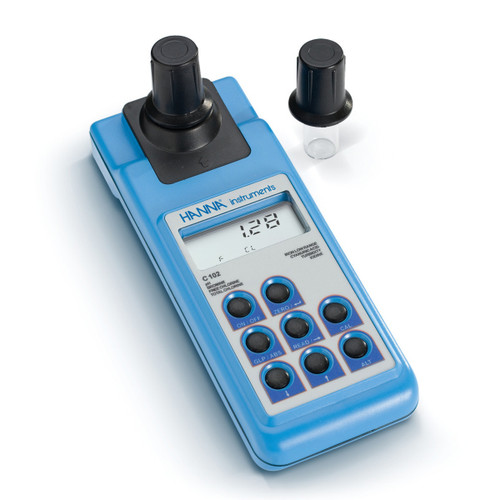The HI98703 is a high accuracy (±2% of reading plus 0.02 NTU) Turbidity Portable Meter. The meter is supplied complete with AMCO-AEPA-1 primary turbidity standards used for calibration and performance verification.
The HI98703 meets and exceeds the requirements of EPA Method 180.1 and Standard Methods for the Examination of Water and Wastewater 2130 B for turbidity measurements.
- Never miss a measurement with stored logging.
- GLP (Good Laboratory Practice) function for calibration traceability.
- Specially designed for water quality measurements.
The HI98703 Precision Turbidity Portable Meter is specially designed for water quality measurements, providing reliable and accurate readings, especially in the low turbidity range. The instrument is based on a state-of-the-art optical system which guarantees accurate results, assures long term stability, and minimizes stray light and color interferences. Periodic calibration with the supplied standards compensates for any variations in intensity of the tungsten lamp. The 25 mm round cuvettes composed of special optical glass guarantee the repeatability of turbidity measurements.
Features at-a-glance
Multiple reading modes - Normal measurement, continuous measurement, or signal averaging measurement are reading modes available.
EPA Compliant Measurement - The HI98703 meets and exceeds the requirements of EPA and Standard Methods for turbidity measurements. When the meter is in EPA mode all turbidity readings are rounded accordingly to meet reporting requirements.
Calibration – A two, three, or four-point turbidity calibration can be performed by using the supplied (<0.10, 15.0, 100, and 750 NTU) standards. Calibration points can be modified if user-prepared standards are used.
AMCO AEPA-1 Primary Turbidity Standard - The AMCO AEPA-1 supplied standards are recognized as a primary standard by the USEPA. These non-toxic standards are made of styrene divinylbenzene polymer spheres that are uniform in size and density. The standards are reusable and stable with a long shelf life.
Fast Tracker™ - For advanced field applications, the HI98703 is equipped with Fast Tracker™ - Tag Identification System (T.I.S.) that makes data collecting and management simpler than ever. Fast Tracker™ allows users to record the time and location of a specific measurement or series of measurements using iButton® tags near sampling points for quick and easy readings. Each iButton® tag contains a computer chip with a unique identication code encased in stainless steel.
GLP Data – The HI98703 features complete GLP (Good Laboratory Practice) functions that allow traceability of the calibration conditions. Data includes calibration points, date, and time.
Data Logging – Up to 200 measurements can be stored in the internal memory and recalled at any time.
Data Transfer – For further storage or analysis options, logged data can be downloaded to a Windows compatible PC using the RS232 or USB port and the HI92000 software.
Backlit Display – A backlit LCD display provides an easy to understand, user-friendly interface. Displayed codes guide the user step-by-step through routine operation and calibration.
Significance of Use
- Turbidity is one of the most important parameters used to determine the quality of drinking water. Once considered as a mostly aesthetic characteristic of drinking water, significant evidence exists that controlling turbidity is a competent safeguard against pathogens. In natural water, turbidity measurements are taken to gauge general water quality and its compatibility in applications involving aquatic organisms. The monitoring and treatment or wastewater was once solely based on the control of turbidity. Currently, the measurement of turbidity at the end of the wastewater treatment process is necessary to verify that the values are within regulatory standards.
Turbidity of water is an optical property that causes light to be scattered and absorbed, rather than transmitted. The scattering of light that passes through a liquid is primarily caused by the suspended solids present. The higher the turbidity, the greater the amount of scattered light. Even a very pure liquid will scatter light to a certain degree, as no solution will have zero turbidity.
Drinking water treatment plants that obtain water from surface water are required by the EPA to monitor and report the turbidity. Surface water sources include lakes and rivers. The requirements of the nephelometer and reporting measurements according to EPA Method 180.1 are: - The applicable range is 0-40 nephelometric turbidity units (NTU)
- Light source: Tungsten lamp operated at a color temperature between 2200-3000°K.
- Distance traversed by incident light and scattered light within the sample tube: Total not to exceed 10 cm.
- Detector: Centered at 90° to the incident light path and not to exceed ±30° from 90°. The detector, and filter system if used, shall have a spectral peak response between 400 nm and 600 nm
- The sensitivity of the instrument should permit detection of a turbidity difference of 0.02 NTU or less in waters having turbidities less than 1 unit.
Report results as follows:
|
NTU reading |
Rounded to nearest |
|
0.0 - 1.0 |
0.05 |
|
1 - 10 |
0.1 |
|
10 - 40 |
1 |
|
40 - 100 |
5 |
|
100 - 400 |
10 |
|
400 - 1000 |
50 |
|
>1000 |
100 |














